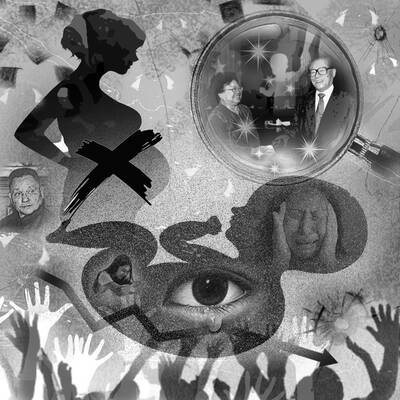Today marks the 30th anniversary of the Tiananmen Square Massacre, when on June 3 and 4, 1989, the Chinese People’s Liberation Army brutally suppressed pro-democracy demonstrators in Beijing and surrounding areas.
The Chinese Communist Party (CCP) normally maintains a stony silence over the events that occurred on those two blood-soaked nights, and through a combination of aggressive censorship and harassment of victims’ families has effectively airbrushed the event from the collective consciousness of the Chinese public.
An exception occurred on Sunday, when Chinese Minister of National Defense General Wei Fenghe (魏鳳和), after delivering a saber-rattling speech at the Shangri-La Dialogue in Singapore, took a question from an audience member about the massacre.
Wei said that measures taken by the government to quell the “turbulence” were the “correct policy.”
“The 30 years have proved that China has undergone major changes,” he said, adding that because of the government’s actions at that time, “China has enjoyed stability and development.”
Wei’s historical revisionism is concerning. It indicates that the party feels fully exonerated by China’s meteoric economic rise.
In a macabre illustration of Orwellian doublethink, the party appears to believe that the bloody crackdown, far from being a catastrophic misjudgement, was in fact beneficial to the country’s development.
Nothing could be further from the truth. Recently uncovered information shows that the massacre was callous, indiscriminate killing for which there can be no justification in a civilized society.
A declassified diplomatic cable from then-British ambassador to China Alan Donald was published by Hong Kong news Web site HK01 in 2017. In the cable, Donald provided information passed on to him by a “reliable” source, who he attributed as a “close friend” of a member of the Chinese State Council — the country’s highest administrative authority.
The source said that the killings were carried out by the 27th Group Army, made up of troops from Shanxi Province, who were “60 percent illiterate and are called primitives.” They were kept without news for 10 days and were told they were taking part in an exercise.
In the first waves of attacks in areas away from Tiananmen Square, unarmed and lightly armed soldiers from other units tried, unsuccessfully, to clear the crowds. The 27th’s armored personnel carriers (APCs) then attacked, opening fire on the crowd — both civilians and soldiers — before running them over. The 27th was ordered to spare no one; even wounded soldiers were shot.
Donald said: “On arrival at Tiananmen ... students understood they were given one hour to leave the square, but after five minutes APCs attacked. Students linked arms, but [were] mown down by soldiers. APCs then ran over bodies time and time again to make ‘pie’ [and the] remains were collected by bulldozer. Remains were incarcerated and then hosed down drains.”
He relayed barbaric scenes: Four wounded female students begged for their lives, but were ruthlessly bayoneted; a mother was shot as she attempted to rescue her injured three-year-old daughter — six others tried to help, but were also shot; army snipers “shot many civilians on balconies, street sweepers, etc, for target practice.”
He ended the cable: “Minimum estimate of civilian dead 10,000.”
Previous estimates ranged from several hundred to more than 1,000.
In today’s uncertain world, it has never been more important that the victims of the Tiananmen Square Massacre be remembered. The CCP was then, and still is today, a brutal dictatorship with not one iota of respect for human life.
We are used to hearing that whenever something happens, it means Taiwan is about to fall to China. Chinese President Xi Jinping (習近平) cannot change the color of his socks without China experts claiming it means an invasion is imminent. So, it is no surprise that what happened in Venezuela over the weekend triggered the knee-jerk reaction of saying that Taiwan is next. That is not an opinion on whether US President Donald Trump was right to remove Venezuelan President Nicolas Maduro the way he did or if it is good for Venezuela and the world. There are other, more qualified
The immediate response in Taiwan to the extraction of Venezuelan President Nicolas Maduro by the US over the weekend was to say that it was an example of violence by a major power against a smaller nation and that, as such, it gave Chinese President Xi Jinping (習近平) carte blanche to invade Taiwan. That assessment is vastly oversimplistic and, on more sober reflection, likely incorrect. Generally speaking, there are three basic interpretations from commentators in Taiwan. The first is that the US is no longer interested in what is happening beyond its own backyard, and no longer preoccupied with regions in other

Jan. 1 marks a decade since China repealed its one-child policy. Just 10 days before, Peng Peiyun (彭珮雲), who long oversaw the often-brutal enforcement of China’s family-planning rules, died at the age of 96, having never been held accountable for her actions. Obituaries praised Peng for being “reform-minded,” even though, in practice, she only perpetuated an utterly inhumane policy, whose consequences have barely begun to materialize. It was Vice Premier Chen Muhua (陳慕華) who first proposed the one-child policy in 1979, with the endorsement of China’s then-top leaders, Chen Yun (陳雲) and Deng Xiaoping (鄧小平), as a means of avoiding the
As technological change sweeps across the world, the focus of education has undergone an inevitable shift toward artificial intelligence (AI) and digital learning. However, the HundrED Global Collection 2026 report has a message that Taiwanese society and education policymakers would do well to reflect on. In the age of AI, the scarcest resource in education is not advanced computing power, but people; and the most urgent global educational crisis is not technological backwardness, but teacher well-being and retention. Covering 52 countries, the report from HundrED, a Finnish nonprofit that reviews and compiles innovative solutions in education from around the world, highlights a